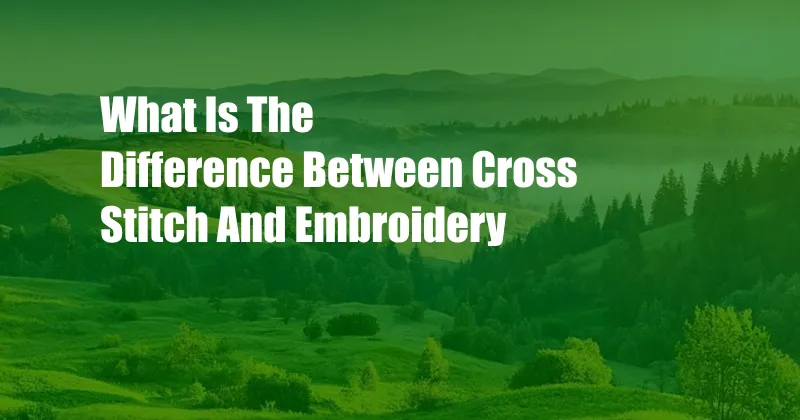
Discover The Artful Distinction: Cross Stitch vs. Embroidery
Growing up in a quaint countryside cottage, I vividly recall the gentle hum of my grandmother’s sewing machine as she immersed herself in intricate creations. Inspired by her artistry, I ventured into the realm of textile crafts, where I first encountered the captivating worlds of cross stitch and embroidery. While both share the thread and needle as their common tools, unraveling their distinct characteristics unveiled a fascinating tapestry of differences.
Embarking upon this journey of discovery, let us delve into the nuances that set these two beloved art forms apart.
Cross Stitch: The Pixelated Masterpiece
Cross stitch captivates with its pixelated charm, resembling a miniature canvas woven to life with colorful threads. Its essence lies in the precise placement of X-shaped stitches over a gridded fabric, creating a mosaic-like effect. This systematic approach lends itself to intricate designs, often featuring bold patterns and geometric motifs. Whether adorning a sampler, cushion, or framed masterpiece, cross stitch transforms ordinary textiles into vibrant works of art.
Embroidery: A Free-Form Dance
In contrast to the structured nature of cross stitch, embroidery embraces a free-form spirit, allowing the artist’s creativity to roam unrestrained. Threads become the brushstrokes, as skilled hands guide them with delicate precision, forming a myriad of stitches that dance across the fabric. From intricate beadwork and shimmering sequins to the vibrant hues of silk and metallic threads, embroidery elevates textiles with an unparalleled depth and texture. Whether depicting realistic scenes, abstract forms, or personal narratives, embroidery transforms cloth into a canvas for storytelling.
The Evolution of Cross Stitch and Embroidery
The origins of these textile arts can be traced back to ancient civilizations. Cross stitch, believed to have emerged in the Middle East, adorned garments and household linens, carrying cultural significance and symbolic motifs. Embroidery, too, has a rich history, with its roots in China, where it flourished as a form of artistic expression and refinement.
Over centuries, both cross stitch and embroidery have evolved, influenced by cultural exchanges, technological innovations, and artistic movements. Cross stitch gained popularity in Europe during the Victorian era, becoming a beloved pastime for women seeking both creativity and accomplishment. Embroidery, meanwhile, has remained a vibrant and diverse art form, embracing new techniques and incorporating elements from diverse cultures, from traditional Japanese embroidery to contemporary machine embroidery.
Contemporary Expressions of Cross Stitch and Embroidery
In the present day, cross stitch and embroidery continue to thrive, finding expression in both traditional and contemporary contexts. Traditionalists cherish the timeless appeal of cross stitch, using it to create heirloom-quality pieces and preserve cultural heritage. Embroidery, likewise, flourishes in the hands of skilled artisans who preserve ancient techniques and передают down knowledge through generations.
Yet, these art forms are not confined to the past. Contemporary artists are pushing the boundaries of cross stitch and embroidery, incorporating them into mixed media作品, installations, and wearable art. From subversive cross stitch pieces that challenge societal norms to immersive embroidered environments that invite interaction, these innovative expressions reveal the enduring relevance and versatility of these textile arts.
Tips for Cross Stitch and Embroidery Enthusiasts
Whether you’re a seasoned cross stitcher or an aspiring embroidery artist, honing your skills requires dedication and a few essential tips:
- Practice makes perfect: The best way to improve your cross stitch or embroidery skills is through consistent practice. Dedicate time to mastering basic stitches and experimenting with different techniques.
- Choose quality materials: Invest in high-quality fabric, threads, and needles that are suitable for your project. This will ensure both the durability and beauty of your creations.
- Plan your design: Before you begin stitching, take the time to carefully plan your design, including the placement of stitches and colors. This will help you avoid mistakes and achieve the desired outcome.
- Follow instructions meticulously: If you’re working from a pattern, follow the instructions precisely. This will prevent errors and ensure your project turns out as intended.
- Don’t be afraid to experiment: Once you’ve mastered the basics, don’t be afraid to experiment with different stitches, colors, and techniques. This is where you can truly unleash your creativity and create unique and personal pieces.
Frequently Asked Questions About Cross Stitch and Embroidery
Q: What’s the difference between cross stitch and embroidery?
A: Cross stitch uses X-shaped stitches over a gridded fabric, while embroidery involves using various stitches to create designs on fabric.
Q: Which is easier to learn, cross stitch or embroidery?
A: Cross stitch is generally considered easier for beginners due to its structured nature. However, both art forms require patience and practice to master.
Q: What are the most common uses for cross stitch and embroidery?
A: Cross stitch is often used for creating samplers, cushions, and framed pieces. Embroidery is versatile, used to embellish clothing, accessories, and home décor items.
Q: Can I combine cross stitch and embroidery in one project?
A: Yes, many artists combine cross stitch and embroidery to create unique and intricate pieces that blend the characteristics of both techniques.
Conclusion
The worlds of cross stitch and embroidery offer boundless opportunities for creativity and self-expression. Whether you seek the structured precision of cross stitch or the free-spirited artistry of embroidery, there’s a niche that awaits your exploration. Embrace the distinct characteristics of these two art forms, and let your passion guide you as you stitch your way to textile masterpieces.
Are you ready to embark on your own cross stitch or embroidery journey? Share your thoughts and questions in the comments below, and let’s continue the conversation about these enchanting art forms.